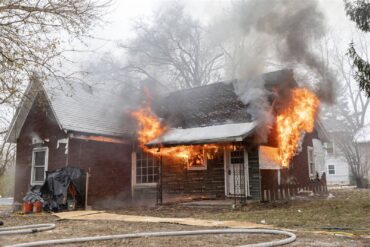 Are you getting ready for a summer vacation? No matter what type of trip you have planned, you want all your memories to be positive ones. That’s why it’s important to prepare your home for when you’re gone and be safe wherever you are going. One important item that should be on your to-do list both before you leave and when you arrive is fire safety.
Are you getting ready for a summer vacation? No matter what type of trip you have planned, you want all your memories to be positive ones. That’s why it’s important to prepare your home for when you’re gone and be safe wherever you are going. One important item that should be on your to-do list both before you leave and when you arrive is fire safety.
The experts at the Fire Safety Research Institute (FSRI) say there are ways to help prevent and reduce damage to homes even while you’re away, as well as protect yourself and loved ones wherever you are going by following these steps.
Step 1: Verify smoke alarms are working.
Smoke alarms give the earliest possible warning that there is a fire, giving house sitters or neighbors time to get out quickly and safely. Smoke alarms should be installed in every sleeping room, outside each separate sleeping area and on every level of the home, including the basement.
Whether in your home or vacation rental, testing a smoke alarm is simple: Locate the test button on the device and press it. You should hear a very loud beep if it’s working properly. If there is no sound or a weak sound, replace the batteries and test again. If it is a sealed-battery alarm, you’ll need to replace the whole device.
In general, smoke alarms should be tested at least twice per year, but it’s always a good habit to check them before leaving for a vacation.
 Step 2: Close all doors inside the home to slow the spread of a fire.
Step 2: Close all doors inside the home to slow the spread of a fire.
Before you leave on your trip, close all the doors inside your home. Closed doors are an effective barrier between smoke and flame, keeping the people and property behind them safer.
There can be a 900 F temperature difference between a room with an open door and one with a closed door. FSRI testing has shown that a room with an open door may reach 1,000 F during a fire, while a room with a closed door may only reach 100 F.
Make sure house sitters or neighbors checking on your home are also aware of the closed door best practice. And don’t forget to close doors at a vacation rental, also. Sleeping with doors closed or closing doors before leaving is a smart habit no matter where you are.
Step 3: Create a fire escape plan.
People staying at or visiting your home while you are on vacation are not as familiar with your property layout as you are. Likewise, you and loved ones are not as familiar with the summer home where you’re vacationing. That’s why it’s wise to proactively map out escape plans for both.
Strive to make three different escape plans and label them Escape Plan A, B and C for visitors. That way if they can’t see their way out for Escape Plan A, they can turn to Plan B. If all routes are blocked, get behind a closed door, turn on the light and dial 911. That’s Plan C.
Remember that fire moves fast. Plan ahead to save lives.
Step 4: Unplug electronics to prevent a power surge or electrical fire.
Fire departments are experiencing an increase of fire incidents involving lithium-ion battery-powered devices like e-mobility devices like e-bikes and electric scooters. Last year, lithium-ion batteries caused 216 fires, 147 injuries and six deaths in the city of New York alone.
When you leave this summer, don’t leave your lithium-ion battery-powered devices charging. Overcharging can lead to overheating and thermal runaway, which is an uncontrollable self-heating state. Remind visitors to your home to do the same to protect your property and the people and pets within.
To further mitigate this emerging fire risk, always buy products with a battery and battery system that has been safety-tested by a third-party organization like UL Solutions. Also, reference the manufacturer’s instructions and ensure your charger is the original product that came with the device.
By following these expert tips, you can better protect your home and anyone in it from the risk of fires and minimize risks while on summer vacation. For more insight and advice, visit FSRI.org.





















Comments